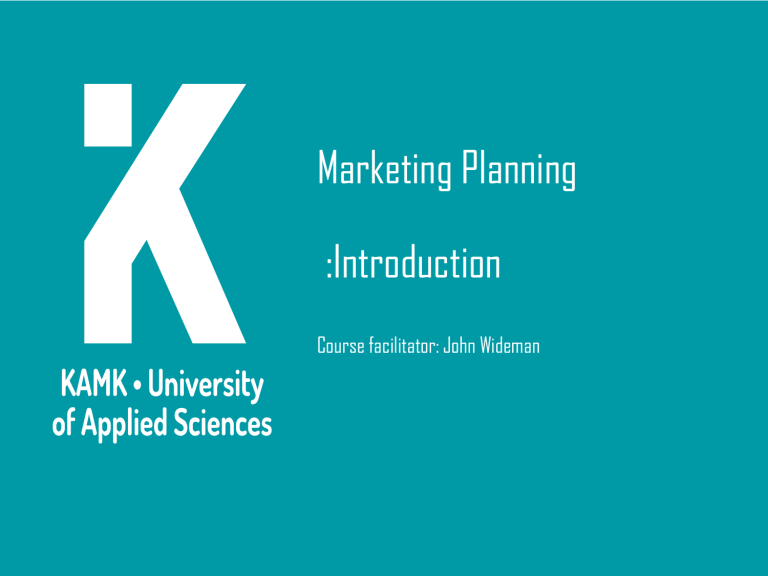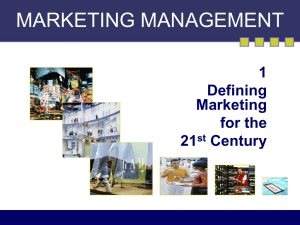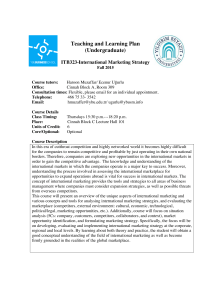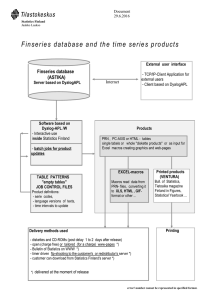
Marketing Planning :Introduction Course facilitator: John Wideman Introductions 1) ART Spend 2 minutes to find a suitable picture that describes how you feel entering this spring 2023 semester. Draw on whiteboard or / share link to picture ON TEAMS 2) SCIENCE 10 secs max per person (remind us of name, country, and EMOTION in 2023) John Wideman • Half British / Half Finnish • Lived in: South East England -2008, Kajaani 2008-2011, Helsinki 2011-2013, Espoo 2013-2017, Kajaani 2017- • Three children • (Hobbies: Football, travelling, nature ……) Academic experience Master’s degree in Business administration (MBA)- International Business Management. Kajaani University of Applied Sciences, Ketunpolku 5, 87100 Kajaani Finland. Bachelor’s Degree in Business Administration (BBA)- International Business. Kajaani University of Applied Sciences, Ketunpolku 5, 87100 Kajaani Finland. REMINDER REMINDER Professional experience 01/01/2020 – Present Lecturer, School of Business, International programme (KAMK, Kajaani, Finland) 02/05/2017 – Present Project Manager / C&D Manager Interregional economic development projects (Kainuun Etu Oy, Seminaarinkatu 2, 87100 Kajaani, Finland) 15/11/2017 - Present Founder/ Owner / Head of Research ( ResultantPro Oy, Kajaani, Finland) 16/05/2013 – 06/2018 Freelance Research Analyst Finland (Euromonitor Intl) 31/03/2012 – 04/2017 Freelance Market Intelligence VIP ( Informed Sources Oy) 13/06/2011 – 12/11/2011 Marketing Research Intern -Kajaani Data Center Cluster Project (Kainuun Etu Oy, Kajaani, Finland) 25/10/2008 - 11/12/2010 Micro - Entrepreneur (Kainuu, Finland) 10/09/2007 - 17/10/2008 Automotive Retail Department Sales Leader/manager (Halfords PLC ,UK) 10/09/2004 - 10/09/2007 Retail Sales Assistant (Halfords PLC ,UK) Basic course info and structure Type and credits • The course is a compulsory course, part of the Basic Business competence study module. Accordingly the course is designated 3 ECTS credits. Learning outcomes of the course • Students will know the elements of the marketing mix and understands the importance of customer relationship thinking and customer satisfaction as a part of profitable business operations. Students will be able to do the analysis and planning of marketing as well as understands the basic relationship marketing. Recommended optional programme components • The student advisor will recommend optional programme components for each student based on their individual study plan. Assessment criteria Excellent • Knowledge: demonstrates good ability to use and apply the concepts and theoretical framework learned in • Skills: demonstrates ability to critically analyze, compare, combine and select information and present knowledge; demonstrate ability to work independently, responsibly, with initiative and flexibly in all learning demonstrate creative but realistic and pragmatic approach to problem solving • Attitudes: work smoothly and professionally as a team to achieve common goals of the group by applying contributes excellent team work and output Good • Knowledge: demonstrates ability to systematically use the concepts learned in this course with ability to basic knowledge of the theories and concepts learned in this course • Skills: demonstrates ability to select appropriate practices based on acquired knowledge and instructions responsibly completing different tasks in all learning and operational environments; demonstrates ability to under minimal guidance in a reasonable manner to problem solving. • Attitudes: works smoothly and professionally as a team to achieve common goals of the group according to good team work and output Satisfactory • Knowledge: basic ability to identify the main/individual concepts learned in the course and applies basic learned from the course; ability to name and describe the concept. • Skills: demonstrates ability to work in an appropriate manner with more guidance and supervision, though the work; shows basic ability to use the techniques and models of the professional field in basic application • Attitudes: demonstrates professional conduct in communication, updates, interactions within the team and professional ethical principles; team work with peers is largely satisfactory Moodle and Moodle key…………… welcome Sessions • Week 2 - 9 twice per week (week 9 onwards SCM->) • Remember the course participation register (moodle)! Tentative timetable (subject to changes ) Course contents • Elements of the marketing mix Pricing decisions as a competitive tools Marketing process and analysis Marketing planning Relationship marketing Customer service relationship development and profitability • Course deliverables 1) Group work (4 to 6) - marketing plan and presentation comprises 40% of the final grade ( 1-5) 2) Individual/pair Reflective learning diary/blog 40% of the final grade. ( 1-5) 3) Individual - Active participation in the contact lectures, attendance, weekly in-class tasks and homework -15% of the final grade. (0-100) 4) individual/group - jigsaw session 5% of the final grade (pass or fail) TBC Intro- Defining Marketing for the 21st Century Developing Marketing Strategies and Plans final assignment instructions & make teams Gathering Information and Scanning the Environment Creating Customer Value, Satisfaction, and Loyalty *REMIND PECHA KUCHA Analyzing Consumer + business Markets Identifying Market Segments and Targets Dealing with Competition Setting Product Strategy Peer review session for blogs Developing Pricing Strategies and Programs Managing Retailing, Wholesaling, and Logistics + jigsaw intro jigsaw big 4 Designing and Managing Integrated Marketing Channels Introducing New Market Offerings- is marketing mnamgt an art or a science…. Presentations for the marketing plan Learning blog entry examples ( last year) blog tools: blogspot,wordpress etc. PRETTY GOOD pretty good Assessment criteria (Out of 100) : Content, theory and reflection (40) , length (20) ( 2x concepts per session, all sessions covered), language (10) , visuals and creativity (10), referencing (10). References and course material The gist of the course: Combine Art and Science of marketing > We go deeper on familiar ground. PUT on your strategic/planning/management HAT. In class we discuss/test & exchange – at home (in the blog) you reflect/process/exemplify. Chapter 1 Defining Marketing for the 21st Century Intro to Marketing management In this chapter we will address the following questions: What is the new economy like? What are the tasks of marketing? What are the major concepts and tools of marketing? What orientations do companies exhibit in the marketplace? How are companies responding to the new challenges? Old Economy VS New Economy The old economy is based on the Industrial Revolution and on managing manufacturing industries WHILE … The new economy is based on the Digital Revolution and the management of information. The New Economy placed the following capabilities in the hands of consumer: • • • • • Substantial increase in buying power Greater variety of available goods and services Great amount of information about practically anything Greater ease in interacting and placing and receiving orders An ability to compare data on products and services AGREE? What about companies? ????? AND placed the following capabilities in the hands of companies: Operate powerful new information and sales channels Collect richer information about markets, customers, prospects, and competitors Speed up internal communication among employees Have two-way communications with customers and prospects Send promotional tools easily and quickly Able to customize offerings Improve purchasing, recruiting, training and internal and external communication. Maintain cost saving while improving accuracy and service quality. PHILOSOPHICAL QUESTION? In this digital age, do you feel powerful when buying products and services? Are you in control of your consumption/ spending? Or is the art (science?) of marketing really working? Q: What is Marketing? What is Marketing? Marketing is an organizational function and a set of processes for creating, communicating, and delivering value to customers and for managing customer relationships in ways that benefit the organization and its stakeholders. American Marketing Association (AMA) as "the activity, set of institutions, and processes for creating, communicating, delivering, and exchanging offerings that have value for customers, clients, partners, and society at large" What is Marketing Management? VOLUNTEER ? Marketing management is the art and science of choosing target markets and getting, keeping, and growing customers through creating, delivering, and communicating superior customer value. Selling is only the tip of the iceberg “There will always be need for Definition: ₁ unnecessary, especially through being more than enough. Read. agree? some selling. But the aim of marketing is to make selling superfluous₁. The aim of marketing is to know and understand the customer so well that the product or service fits him and sells itself. Ideally, marketing should result in a customer who is ready to buy. All that should be needed is to make the product or service available.” Peter Drucker 1-24 Question: What is Exchanged in Marketing? 1-25 What is Exchanged in Marketing? Money Goods Services Events & Experiences Persons Places & Properties utility Information Ideas 1-26 A Simple Marketing System 1-27 2002. Kotler, Marketing Concepts and Tools Needs: the basic human requirements Wants: specific objects that might satisfy the need Demand: wants for specific products backed by an ability to pay. Examples: Q: Can you distinguish? An American needs food but wants a hamburger, French fries and soft drink. Many people want a BMW, only a few are able and willing to buy one. 1-28 PHILOSOPHICAL QUESTION?!? Consumers and spending - “Having money gives you the luxury of not having to think about money.” The happiness linked to money is not driven by the possession of shiny things, but is derived from: a) The ability to buy something if you want it (and knowledge that you can) b) The absence of stress or worry when you have to spend money Marketing Discussion Do Marketers Create or Satisfy Needs? 2 mins with your partner---- Marketing Concepts and Tools Product: a value proposition Offering: intangible value proposition (a combination of products, services, information and experiences (Volvo) Brand: is an product/offering from a known source Only the best is good enough for Lexus customers 1-31 Question --- • Do you have a real affinity* to a particular brand? What, and why? *a natural liking for and understanding of someone or something. 2 minute breather Marketing Concepts and Tools Value is a ratio between what customer gets and what s/he gives Value = Benefits/Costs How to increase value? Raise benefits + Reduce costs + Raise benefits and reduce costs ++ Raise benefits by more than the raise of costs + Lower benefits by less than the reduction of costs + Q: Is it easy to understand/gauge value ? 1-34 Marketing Concepts and Tools Exchange: a process of obtaining a product/service from someone by offering something. For exchange to occur, there must be: • Two parties • Each with something of value to the other • Capable of communication and delivery • Free to accept/reject the offer • Agreement to terms Osta ja myy helposti. Ilmoita ilmaiseksi Torissa. Question: Do you use any exchange platforms? Have you traded any goods/services in the past year? (NON monetary xchange) 1-35 Key Marketing Concepts and Tools Relationship: building mutually satisfying long-term relations with key parties (customers, suppliers, distributor) in order to earn and retain their business. Network: building mutually profitable business relationships between the company and its supporting stakeholders. Questions: 1) Wherever you go shopping the MOST; what is the relationship like? 2) Can you think of examples of companies with strong, visible (internal and external) networks / partners? 1-36 Partnerships e.gs Your stories: marketing relationships? Marketing Concepts and Tools Competition: all actual and potential rival offerings and substitutes that a buyer might consider. 1-39 Marketing Concepts and Tools Four (4) levels of competition: 1. 2. 3. 4. Brand competition: A company sees its competitors as other companies offering similar products and services to the same customers at similar prices. (NIKE v ADIDAS) Industry competition: A company sees its competitors as all companies making the same product or class of products. ( BMW v FORD) Form competition: A company sees its competitors as all companies manufacturing products that supply the same services. ( Apple v Toshiba) Generic competition: A company sees its competitors as all companies that compete for the same consumer dollars. (Example: Volkswagen v airbnb) 1-40 The Four Ps Marketing Mix: a set of marketing tools the firm uses to pursue its marketing objectives in the target market. (e.g 4,7,15 p’s) 1-41 Company Orientations to the Marketplace (Marketing Management Philosophies) 4 volunteers 1. Production concept: assumes consumers favor those products that are widely available and affordable. (Focus: wide distribution; high volume). 2. Product concept: assumes consumers will favor those products that offer the most quality, performance, and features. (Focus: Superior product) 1-42 Company Orientations to the Marketplace, cont. 4 volunteers 3. Selling concept: assumes that consumers will either buy or not buy enough of the organizations’ products unless the organization makes a substantial effort to stimulate the customer’s interest in the product. (Focus: needs of the seller) 1-43 “The purpose of marketing is to sell more stuff to more people more often for more money in order to make more profit” Coca-Cola’s former Vice president Agree ? Disagree ? 1-44 Company Orientations to the Marketplace, cont. 4 volunteers 4. Marketing concept: holds that the key to achieving organizational goals consists in determining the needs and wants of target markets and delivering the desired satisfactions more effectively and efficiently than competitors. (Focus: different needs of buyers) 1-45 Marketing and Selling Concepts Contrasted Starting Point Factory Focus Products Means Selling and Promoting Example Ends e.g., Profits through Volume (a) The Selling Concept Market Customer Needs Integrated Marketing e.g., Profits through Satisfaction (b) The Marketing Concept 1-46 What is the difference between marketing and selling? Anyone willing to give it a try…. Theodore Levitt’s “Marketing Myopia,” cont. •What is the difference between marketing and selling? •Selling focuses on the needs of the seller, marketing on the needs of the buyer. Selling is preoccupied with the seller’s need to convert the product into cash; Marketing with the idea of satisfying the need of the customer ….” 1-48 Marketing Concept Four Pillars 1. Target Market: tailored marketing programs (WHO) 2. Customer Needs: (WHAT) Giving customer what they need is not enough; companies must help customers learn what they want. Stated, Real, Unstated, Delight & Secret Needs. (Inexpensive car example) Responsive, Anticipated & Creative Marketer. Market-driving firm VS Market-driven firm. Make and sell VS Sense and respond Philosophy. Why it’s important to satisfy target customers? (Customer retention) 1-49 Marketing Concept Four Pillars 3. Integrated Marketing: all company’s departments work together to serve the customer’s interests. (HOW) a. External marketing: directed at people outside the company. b. Internal marketing: the task of hiring, training, and motivating able employees who want to serve customers well. Which one is more important???????? 4. Profitability – for business continuity, this is a must. ( EUR, DOLLAR; YEN) 1-50 What makes companies adopt the marketing concept? What makes companies adopt the marketing concept? 1. 2. 3. 4. 5. Sales decline Slow growth Changing buying patterns Increasing competition Increasing marketing expenditures 1-52 Company Orientations to the Marketplace 5. The customer concept: • • INDIVIDUAL Customer is the lifeblood of any company Customer is the King 1-53 When you forget about the customer ……… Any more? TIP: Blog topic?!?!?!? •Can you identify/recall modern examples of companies where the customer was forgotten? •What happened? Why? What was the result? Company Orientations to the Marketplace, cont. 6. The societal marketing concept: to determine the needs, wants, and interests of target markets and to deliver the desired satisfaction more effectively and efficiently than competitors in a way that preserves or enhances the consumer’s and the society’s well-being -----and company profits! Marketing Managers Must Balance Profits Public Interest Promote sale of goods and services Long-term needs for a safe and healthy environment Dalrymple & Parsons/Marketing Management 7th edition: Chapter 1 16 1-56 Questions? Thank you ! Task: Choose a blogging tool Add your first entry (at least one topic/ concept per session) See you next time!



